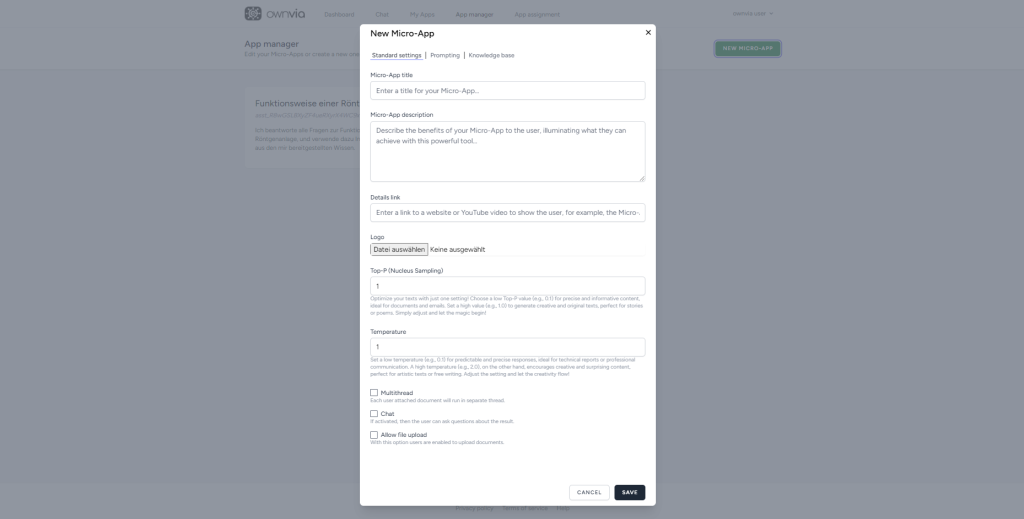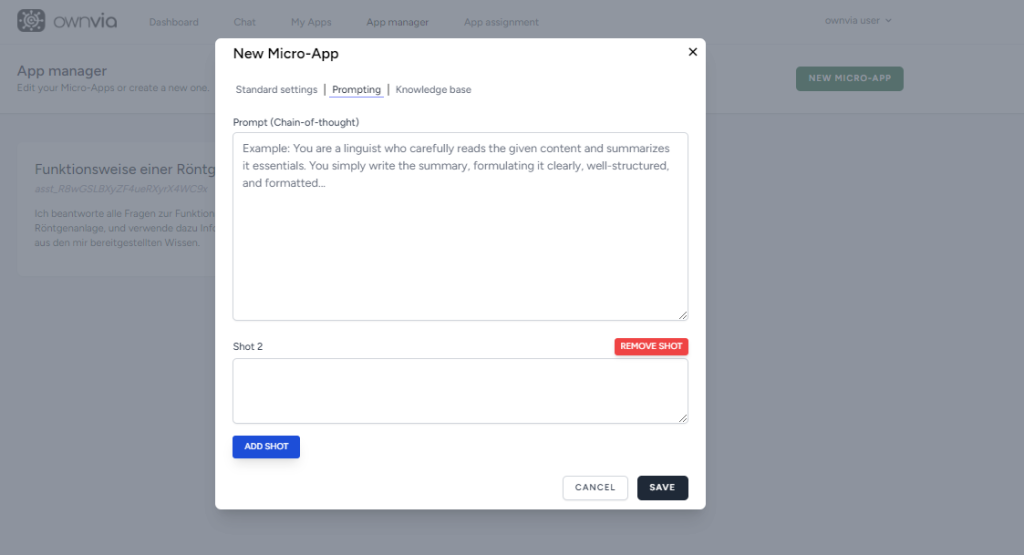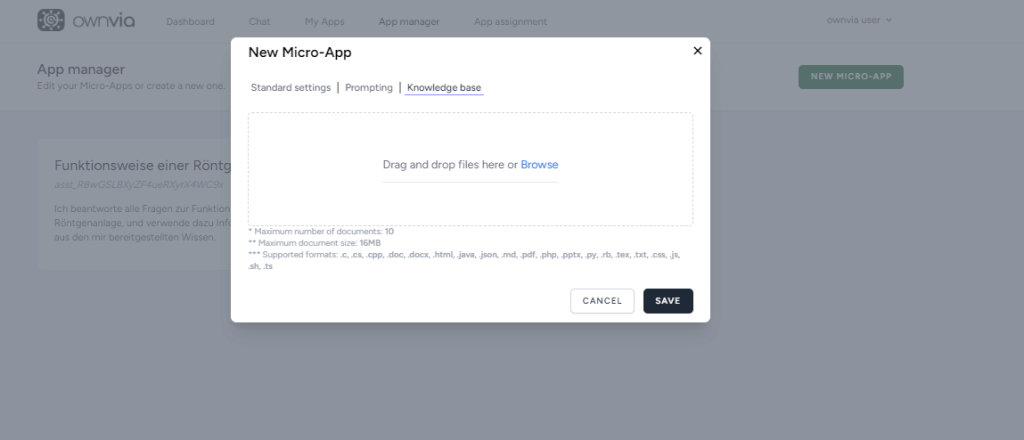Introduction
In today’s digital era, efficiency is key to success. Companies are constantly seeking ways to optimize and automate their processes. ownvia offers a user-friendly platform that allows powerful Micro-Apps to be created without any programming knowledge. In this blog, we will demonstrate how easy it is to create a Micro-App with ownvia and integrate it into your workflows.
Step-by-Step Guide to Creating a Micro-App
1. Sign Up and Access the Platform
The first step is to sign up for the ownvia platform. Visit ownvia.com and register for an account. You will need a Basic User plan to be able to create a Micro-App in ownvia. Once signed up, you will have access to the dashboard where you can manage your Micro-Apps.
2. Launch the Micro-App Manager
Open the “App manager” menu. Click on the “New Micro-App.” button. The intuitive assistant will guide you through the entire process.

3. Enter Basic Information
Give your Micro-App a name and a brief description. This will help you identify the Micro-App later and understand its function.

4. Additional Description Configurations
- Details link: Add a link to a website or a YouTube video that provides additional information to the user. This can be a tutorial video or documentation showing how to use the Micro-App.
- Logo: Upload a logo associated with your Micro-App. This can be the company logo or a specific icon representing the Micro-App.
5. Accuracy Configurations
- Top-P (Nucleus Sampling): Set the Top-P value to control the quality and creativity of text generation. A low value (e.g., 0.1) is suitable for precise and informative texts, ideal for documentation and emails. A high value (e.g., 1.0) produces creative and original texts, perfect for stories or poems.
- Temperature: Adjust the temperature to control the creativity of the generated texts. A low value (e.g., 0.1) delivers predictable and precise answers, ideal for technical reports or professional communication. A high temperature (e.g., 2.0) generates surprising and creative content, perfect for artistic texts or creative writing.
- Multithread: Enable this option to ensure that each uploaded document is processed in a separate thread. This increases the accuracy and clarity of the results.
- Chat: Allow users to ask questions during usage by enabling this option. This promotes interactivity and allows users to ask specific questions about the results of the Micro-App.
- Allow file upload: Enable this option to allow users to upload documents that the Micro-App will analyze or use. This significantly extends the functionality and use cases of the Micro-App.
6. Prompting
The prompting settings are a central component in creating a Micro-App. Here, you define how the AI should respond to queries and perform the desired tasks. The following description shows how to configure these settings.

“Prompt (Chain-of-thought)” Input Mask :
- Description: In this field, you provide an example or a detailed instruction on how the AI should handle tasks. “Chain-of-thought” is a single prompt that guides the AI through a logical and structured sequence of steps to solve a problem or complete a task.
- Example: “You are a linguist who carefully reads the given content and summarizes its essentials. You simply write the summary, formulating it clearly, well-structured, and formatted…” This instruction tells the AI to take on the role of a linguist, carefully reading the content and summarizing the key points.
Add Shot (Few-shot prompting):
- Description: Here, you can provide additional instructions or examples to further train the AI and cover specific scenarios. This is particularly useful for increasing the accuracy and relevance of the responses if you are unable to achieve the best answer with a single ‘Chain-of-thought’ prompt.
- Note: You can add multiple “Shots” by clicking the “ADD SHOT” button. This allows you to provide several examples or scenarios to better train the AI.
Important to Mention: The “Prompting” settings on the ownvia platform offer you the ability to configure the AI precisely and in detail. By entering clear instructions and examples, you can ensure that the Micro-App performs the desired tasks efficiently and effectively. Use these configurations to optimally tailor your Micro-Apps to your needs.
7. Knowledge Base:
The “Knowledge Base” settings are a central component in creating a Micro-App. Here, you can upload relevant documents and data that the Micro-App should use as a knowledge source. This feature leverages Retrieval-Augmented Generation (RAG) technology to provide precise and contextually relevant responses. The following description explains how to configure these settings and what advanced functions are available.

Knowledge Base Input Mask:
- Description: In this section, you can upload files that the Micro-App will use as a knowledge source. This allows the AI to access specific information and provide well-informed answers. The uploaded files serve as the basis for the Micro-App’s responses.
Advanced Functions:
- Exclusive Knowledge: You can configure the Micro-App to use only the uploaded documents as a knowledge source. This ensures that the AI’s responses are based solely on the provided information. This can be used, for example, to create a Micro-App that answers questions about a product, department, process, or similar topics.
- Extended Knowledge Use: The Micro-App can use the uploaded knowledge in an extended manner to provide more comprehensive and informed answers. This allows you to correct public knowledge with your own or extend specific knowledge that is not publicly accessible.
- Analysis Functions: Based on the uploaded knowledge, the Micro-App can perform detailed analyses. This is particularly useful for ensuring that certain standards are met, such as compliance guidelines or specific requirements.
- Style Guides: You can also upload style guides that specify the style, grammar, or terminology requirements. This allows the AI to generate texts consistently according to your specific guidelines.
8. Saving and Deployment
- SAVE: After filling in all the required fields and making the desired settings, click the “SAVE” button to save and deploy your Micro-App.
Conclusion
The input mask for creating a new Micro-App with ownvia is designed to be intuitive and user-friendly. With just a few steps, you can create a powerful and customized Micro-App that optimizes your business processes and increases your efficiency. Try it out and see how easy it is to create productive Micro-Apps with ownvia.



